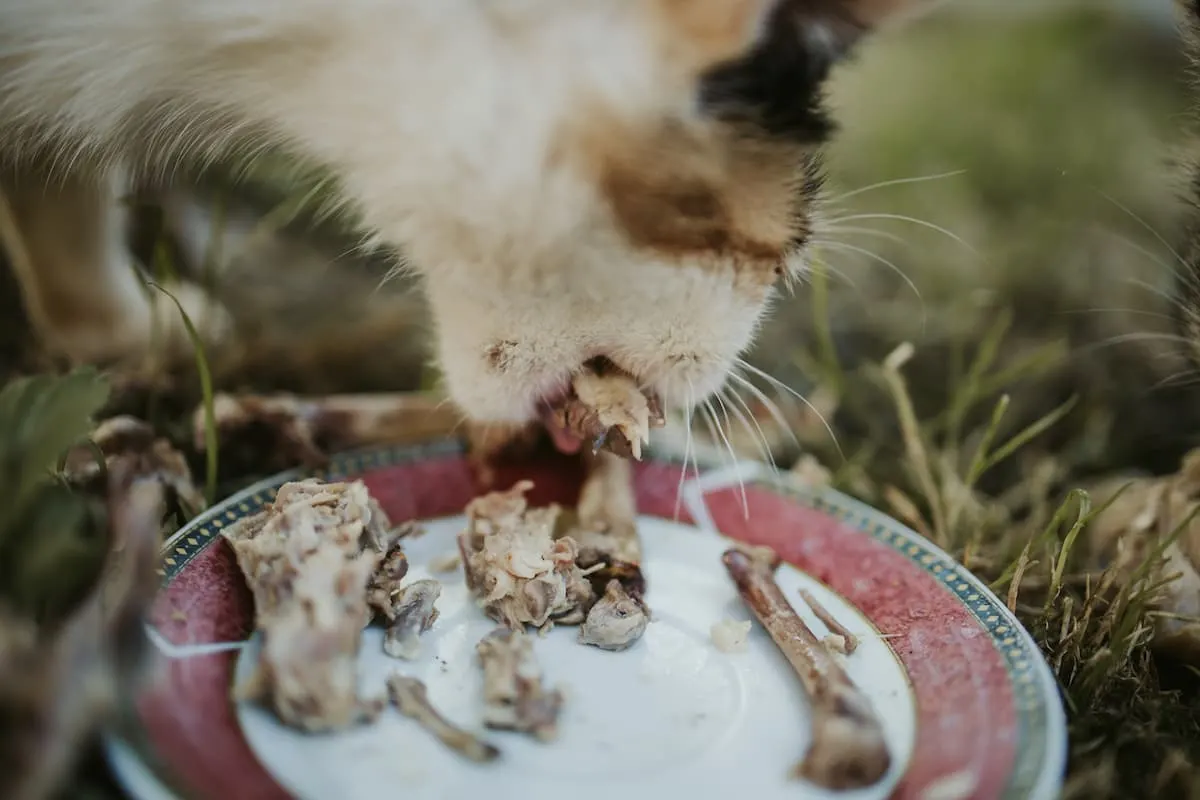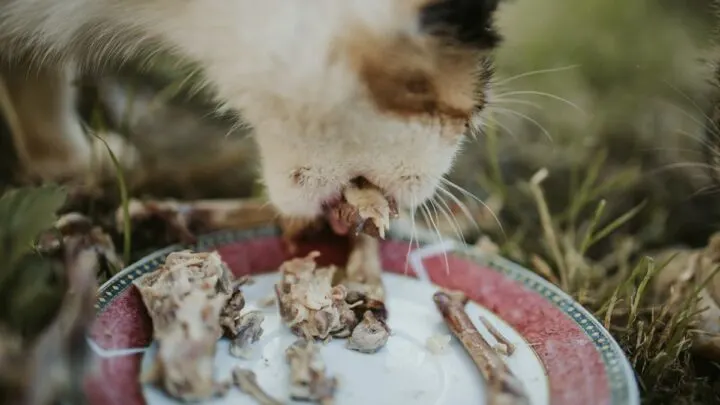Cats are obligate carnivores, so whatever you feed them, you have to make sure their diet is primarily meat-based. Canned food and dry food from pet stores are a great way to ensure they are getting the vitamins and nutrients they need. However, if you opt to prepare meals for your cat yourself, you will need to do some research to make sure you include the right kinds of meat. You will also need to research how to best prepare meat for your cat so they can properly digest it. Also, are the bones in meat a risk to your cat’s health? Can cats digest bones?
Cats can digest bones. Bones are fully digestible for cats and they can provide nutrients and other health benefits to cats.
Eating bones can be a healthy way to add nutrients to their diet.

Is It Okay For Cats To Chew On Bones
Most cat owners don’t think to get their cat a bone to chew on as dog owners do for their dogs. Funny enough, cats enjoy chewing on bones. Their mouths are built perfectly for it too. Their sharp, pointy teeth and their rough tongues are perfect for gnawing on bones.
Chewing on bones provides necessary mental stimulation for their daily routine. If your cat were in the wild, it would have to hunt food and have to figure out how to eat it without any preparation. While they don’t have to hunt bones in your home, they stimulate their brains by figuring out how to chew through the bone to get to the bone marrow. They also experience satisfaction when they reach the reward of eating the bone marrow, which makes them feel like all of their hard work was worth it.
Chewing on bones is also a fantastic way to maintain dental hygiene. Most cats will develop dental disease by age 3, and it tends to be a considerable procedure to get their teeth cleaned. Giving them bones to chew on is a great way to keep dirt and grime off their teeth. When your cat chews on a bone, they will be scraping off the dirt that builds up when they eat. Plus, bones have enzymes that they ingest when chewing. These enzymes break up food particles and help to improve their overall oral health.
Can A Cat’s Stomach Dissolve Bones
Luckily, a cat’s stomach can fully dissolve any bones as they digest. Their stomach acid is strong enough to dissolve bones completely into liquid before they pass through their stomach. Don’t forget, too much of anything can have negative consequences. Feeding your cat bones too frequently without a good balance of meat and other ingredients could lead to their stomach being upset.
What Happens If Your Cat Eats A Bone
If your cat eats a bone and does not regularly eat bones, carefully monitor the situation. Some bones can splinter and get caught in your cat’s throat. Or the splintering can cause minor cuts that can be painful. Make sure your cat can either spit the bone out or entirely swallow it, so it is not stuck in their throat.
They are likely going to be fine, but if you’re concerned about the type of bone they ate, the best course of action is to contact your veterinarian. They may ask you to come in for an emergency visit if they are concerned as well, or they may give you directions to care for your pet at home. As long as your cat continues to play, eat, and drink normally, they are most likely going to be fine.
How Long Does It Take For Cats To Digest Bones
Within about 24 hours of initially ingesting a bone, your cat should have fully digested it. This is good to know while you monitor them for the first time they try a bone or if they accidentally eat one. If 24 hours have passed and they haven’t gotten sick, shown they are in pain or acting weird, then you can assume they have digested it safely, especially if they have continued to eat their other food and drink water consistently. You can also check their stool to make sure there aren’t any blood or bone fragments. If their stool looks normal, then they can fully digest the bone they ate.
What Bones Are Safe For Cats
Raw bones are the safest bones for cats to ingest. If they are cooked or dehydrated, they have a higher possibility of splintering, which can harm your cat. Bare bones can be dangerous for this reason as well, so be sure to get raw bones with a nice amount of meat around them. You also want to get bones that are relative to your cat’s size and something they could have hunted in the wild. This ensures they are able to eat the bones, and it won’t be too big for them.
The following bones are safe for cats to eat:
- Chicken feet, back, neck, and small wings
- Rabbit front legs and ribs
- Small duck neck
- Quail (all parts are safe)
- Coquelet (all parts are safe)
If you consider adding raw bones to your cat’s diet, start with something small like a quail or rabbit ribs. You don’t want to overwhelm them too much and upset their sensitive stomachs. Easing them into the diet is going to be most comfortable for them.
Is It Healthy For Cats To Eat Bones
It is very healthy for cats to eat bones. It is smart for all cats to have bones introduced to their diets, but it is especially great for nutrient deficient cats to keep them feeling strong and healthy.
The biggest reason that bones are healthy for cats is because of all of the protein they get from eating them. This protein helps to give them energy and keeps their muscles nice and strong. Bones also help to protect organ health by preventing bacteria from traveling further into their digestive system. The enzymes in bones help to combat bacteria and keep your cat’s mouth healthy. Cats can also get their daily dose of calcium from eating bones, which in turn helps to keep their bones nice and strong.
Things To Consider
Everything should be enjoyed in moderation. If you add raw bones to your cat’s diet, it is still recommended that they only eat them 1-2 times a week. You should continuously monitor them while they eat the bones to ensure they don’t choke or get hurt. If your cat doesn’t enjoy eating raw bones, there are still plenty of other ways to add more nutrients to their diet.

My name is James, and welcome to FAQCats!
Along with our team of cat owners, expert pet enthusiasts, and pet professionals, we aim to write engaging helpful, engaging content about cats. At FAQCats we strive to provide content that’s accurate and fun to read. Our team writes about everything related to cats; even the most complex of topics. Through extensive research and caring for our own fur-pals, we’re able to provide something cat owners worldwide will love. Have a look around, and leave us feedback anytime!

